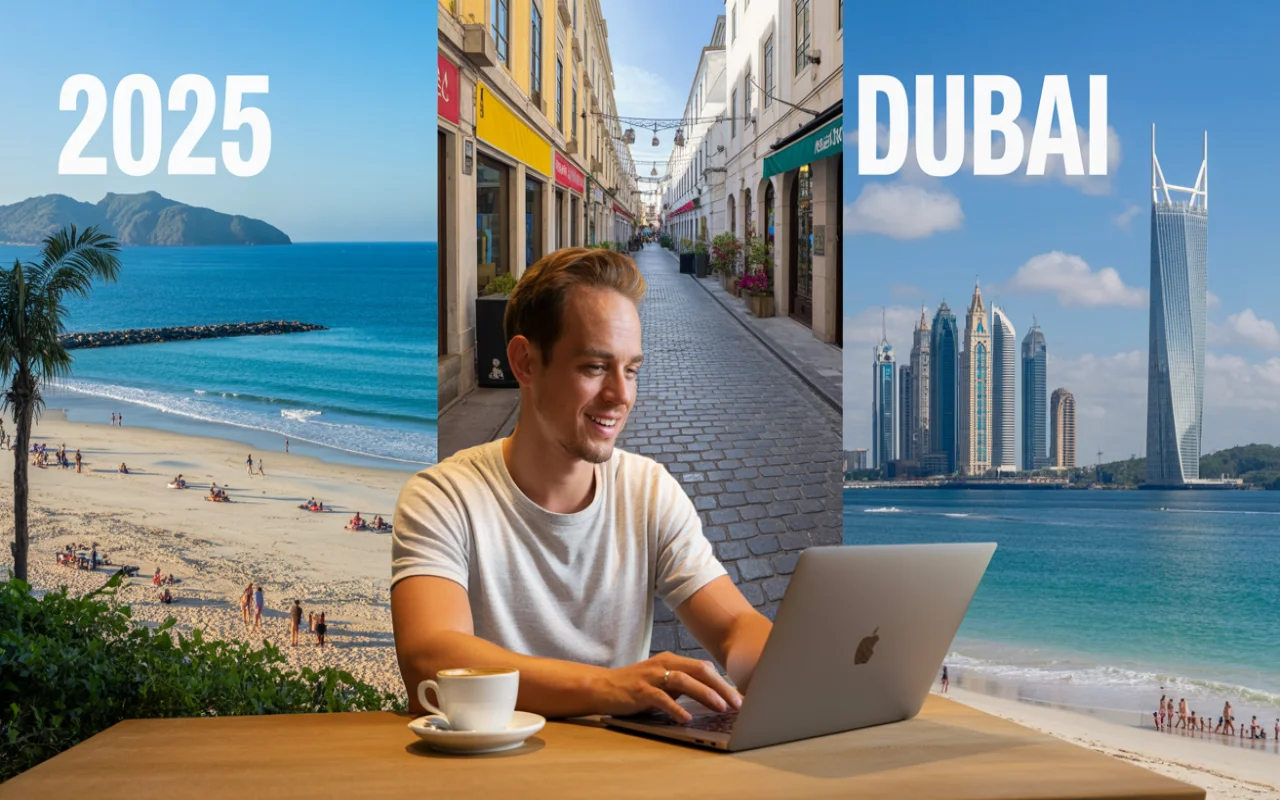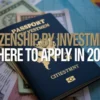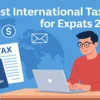Hey there, fellow wanderers! I’m thrilled to dive into this topic with you because, let’s face it, who hasn’t dreamed of swapping that stuffy office for a beachside cafe or a bustling European square? As someone who’s chased the sun while juggling deadlines, I can tell you that remote work abroad is more than a trend it’s a game-changer for your life and career. In 2025, with technology bridging gaps like never before, we’re seeing an explosion in the digital nomad lifestyle, where you can work while traveling without missing a beat. This post is your ultimate guide to the best places for remote work, packed with insights on visas, costs, and hidden gems. Whether you’re a freelancer eyeing countries for freelancers or a pro seeking remote careers with global mobility, I’ve got you covered. Let’s unpack why 2025 is your year to hit the road.
Imagine logging into a Zoom call with ocean waves crashing in the background—that’s the magic of remote work abroad. But it’s not just about pretty views; it’s about reshaping your routine for more freedom and fulfillment. I’ve chatted with countless nomads who’ve traded commutes for adventures, and the stories are inspiring. From expat jobs in vibrant cities to quiet retreats, the options are endless. Stick around as we explore trends, benefits, and my top picks to make your transition smooth.
Key Takeaways
- Remote work abroad in 2025 is booming, with over 70 countries offering digital nomad visas for easier stays.
- Affordable destinations like Bali and Chiang Mai let you live well on $800–$1,500 a month, boosting your savings.
- Key factors include fast internet (aim for 100 Mbps+), co-working spaces, and safety don’t overlook them!
- Top perks: Better work-life balance, cultural immersion, and professional growth through global networks.
- Prep smart: Budget for visas, pack tech essentials, and research work visas 2025 to avoid hiccups.
The Rise of Remote Work and Digital Nomadism in 2025
You know, when I first started dipping my toes into remote work abroad, it felt like a wild experiment. But fast-forward to 2025, and it’s mainstream magic. The pandemic kicked things off, but now, with AI tools making collaboration seamless, more folks are embracing the digital nomad lifestyle. Stats show that remote-capable workers are split about 50% hybrid, 30% fully remote that’s a huge leap from pre-2020 days. Companies are finally getting it: Happy, location-free employees mean better productivity. I’ve seen friends ditch desk jobs for work while traveling, and they’re thriving. It’s like the world shrunk, thanks to 5G and cloud everything.
What excites me most is how this shift is reshaping economies. Countries are rolling out welcome mats with work visas 2025 tailored for us nomads, injecting fresh cash into local scenes. Think about it your coffee run supports a family-run cafe in Thailand. But it’s not all rosy; challenges like time zones pop up. Still, the rise feels unstoppable, like a wave carrying us to new horizons.
Why 2025 is the Perfect Year for Digital Nomads
Picture this: You’re sipping fresh coconut water, laptop open, deadline met that’s 2025 for you. Why now? Well, remote jobs have tripled since 2020, making up 15% of U.S. opportunities alone. Governments are catching on, with over 66 countries launching or updating digital nomad programs. It’s like the universe aligned for global mobility. I’ve talked to nomads who say AI automation frees up time for exploration, turning work into play.
Emerging trends like hybrid models mean you can mix office vibes with adventures. Stats predict 40% of the workforce going location-independent. Rhetorically, isn’t it time you joined? Economic perks, like lower costs in Asia, make it feasible. But remember, sustainability matters choose spots that value eco-tourism to keep the magic alive.
Benefits of Working Remotely Abroad
Let me tell you, jumping into remote work abroad flipped my world upside down in the best way. The freedom to choose your backdrop? Priceless. You wake up energized, not drained from commutes. It’s like trading a cage for wings, soaring through remote careers that fit your vibe.
Beyond the thrill, it’s practical. Your wallet thanks you, and your mind expands. I’ve felt more creative tackling projects from a hammock than a cubicle. Ever wondered why? Novel environments spark ideas, like a fresh canvas for your brain.
- Cost Savings: Stretch your salary further in low-cost havens.
- Work-Life Balance: Blend tasks with leisure, reducing burnout.
- Cultural Growth: Immerse in new worlds, building empathy and skills.
- Networking: Connect globally, opening doors to expat jobs.
- Health Boost: Access nature and wellness spots for better well-being.
Cost Savings and Affordable Living
One of my favorite perks? Watching my bank account smile. In places like Medellín, you live comfortably on $1,200 a month half what you’d spend in a big U.S. city. It’s like getting a raise without asking. Groceries, rent, even fun outings cost less, letting you save or splurge on experiences.
But it’s not just numbers; it’s freedom. I once budgeted for a year abroad and ended up with extra for side trips. Affordable living means less stress, more focus on what matters. Just watch exchange rates they’re your new best friend.
Enhanced Work-Life Balance
Ah, the holy grail: Balance. Remote work abroad lets you design days around you, not a clock. Start with yoga, end with sunsets it’s rejuvenating, like recharging your soul’s battery. Studies show remote folks report 30% less burnout.
I’ve experienced it firsthand; boundaries blur positively. No rush hour means more family time or hobbies. But set routines it’s easy to overwork in paradise. Trust me, a balanced nomad is a happy one.
Cultural and Professional Growth
Diving into new cultures? It’s rocket fuel for growth. Work while traveling exposes you to diverse ideas, sharpening your edge in remote careers. I’ve picked up languages and perspectives that wow clients.
Professionally, networks expand exponentially. Co-working spaces buzz with innovators, like a global brainstorm. Metaphorically, it’s planting seeds in fertile soil your career blooms. Embrace discomfort; it’s where magic happens.
Essential Factors for Choosing a Remote Work Destination
Choosing your spot isn’t random it’s strategic. I’ve learned the hard way: Prioritize what keeps you productive and safe. Think of it as matchmaking for your lifestyle.
Research deeply; user searches for “best places to work remotely 2025” spike for a reason. Balance dreams with reality internet first, vibes second.
Reliable Internet and Co-Working Spaces
Nothing kills flow like spotty Wi-Fi. Aim for 100 Mbps minimum; places like Seoul deliver 1 Gbps. It’s your lifeline, like oxygen for divers.
Co-working spots? Goldmines for community. Hubs like WeWork foster connections, turning solo work into social fuel. I’ve made lifelong friends there don’t skip this.
Digital Nomad Visa Options in 2025
Visas are your golden ticket. In 2025, options abound Greece’s is easiest, requiring $3,500 monthly. Portugal’s D8 needs $3,000; stays up to two years.
Stay updated; new programs pop up. It’s like a visa buffet pick what fits your income and plans. I’ve navigated a few; preparation pays off.
Safety, Healthcare, and Quality of Life
Safety first check indexes like Numbeo. Quality life? Fresh air, good food, friendly locals elevate everything.
Healthcare matters; English-speaking docs ease worries. It’s holistic your spot should nurture body and mind, like a cozy nest.
Top 10 Destinations for Remote Workers in 2025
Excited? These top digital nomad destinations 2025 blend affordability, infrastructure, and allure. From Asia’s vibes to Europe’s charm, they’re nomad-approved.
I’ve curated based on trends visas, costs, communities. Ready to pick your paradise?
| Destination | Average Monthly Cost | Internet Speed | Visa Option | Key Highlight |
| Bali, Indonesia | $800–$1,500 | 50–100 Mbps | B211A (extendable) | Tropical wellness hub |
| Lisbon, Portugal | $1,500–$2,000 | 200+ Mbps | D8 Visa | Vibrant tech scene |
| Medellín, Colombia | $1,200–$1,800 | 100 Mbps | M Visa | Eternal spring weather |
| Chiang Mai, Thailand | $800–$1,200 | 100 Mbps | Elite Visa | Temple tranquility |
| Tenerife, Spain | $1,200–$1,800 | 200 Mbps | Non-Lucrative | Volcanic adventures |
| Prague, Czech Republic | $1,300–$1,800 | 500 Mbps | Schengen | Fairy-tale history |
| Seoul, South Korea | $1,400–$2,000 | 1 Gbps | D-8 Visa | Futuristic tech |
| Buenos Aires, Argentina | $900–$1,500 | 100 Mbps | Digital Nomad Visa | Tango culture |
| Timisoara, Romania | $800–$1,200 | 200 Mbps | Long-stay | Affordable EU access |
| Athens, Greece | $1,100–$1,600 | 100+ Mbps | Digital Nomad Visa | Ancient wonders |
1. Bali, Indonesia
Bali’s my eternal favorite beaches, vibes, endless inspiration. It’s a nomad magnet, with over 100,000 visitors yearly. Ubud’s serene, Canggu’s surfy; pick your poison.
Costs stay low, culture high. It’s like a reset button for your soul.
Pros, Cons, and Tips for Bali
Pros: Stunning nature, cheap eats, wellness focus. Cons: Traffic, rainy seasons. I’ve battled scooters plan around it.
Tips: Visa on arrival, extend; use Hubud for work. Pack light, embrace island time it’s transformative.
2. Lisbon, Portugal
Lisbon’s sunny soul captivates. Tech hub with EU perks, it’s nomad central. Pastel buildings, ocean views pure joy.
Community thrives; events abound. It’s like Europe’s welcoming hug.
Pros, Cons, and Tips for Lisbon
Pros: Mild weather, fast net, affordable. Cons: Crowds, rising rents. I’ve navigated stay peripheral.
Tips: D8 visa easy; explore Alfama. Network at meetups opportunities flow.
3. Medellín, Colombia
Medellín’s transformation? Inspiring. Eternal spring, innovative spirit nomads flock.
Affordability shines; culture pulses. Like a phoenix rising.
Pros, Cons, and Tips for Medellín
Pros: Weather, low costs, friendly locals. Cons: Safety in spots. I’ve felt secure stick to expat areas.
Tips: M visa; Comuna 13 tours. Budget wisely it’s rewarding.
4. Chiang Mai, Thailand
Chiang Mai’s chill vibes? Unmatched. Temples, mountains peaceful productivity.
Food scene’s heaven; costs minimal. Like a gentle breeze.
Pros, Cons, and Tips for Chiang Mai
Pros: Serenity, co-working, cuisine. Cons: Air quality seasonally. I’ve timed visits avoid burn.
Tips: Elite visa; Punspace hubs. Dive into markets soul food.
5. Tenerife, Spain
Tenerife’s volcanic charm? Underrated gem. Beaches, hikes adventure awaits.
EU access easy; weather perfect. Like Spain’s wild child.
Pros, Cons, and Tips for Tenerife
Pros: Nature, surf, reliable infra. Cons: Isolation. I’ve loved solitude recharge gold.
Tips: Non-Lucrative visa; Teide hikes. Connect locally hidden spots.
6. Prague, Czech Republic
Prague’s fairy-tale streets? Magical. History meets modern work.
Affordable Europe; beer bonus. Like stepping into a storybook.
Pros, Cons, and Tips for Prague
Pros: Architecture, speed, culture. Cons: Winters cold. I’ve bundled up worth it.
Tips: Schengen stay; cafe work. Explore bridges inspiration flows.
7. Seoul, South Korea
Seoul’s tech pulse? Electrifying. Skyscrapers, K-culture future-forward.
Innovation hub; net unbeatable. Like a sci-fi set.
Pros, Cons, and Tips for Seoul
Pros: Ultra-fast Wi-Fi, food, transit. Cons: Language barrier. I’ve used apps manageable.
Tips: D-8 visa; Myeongdong explores. Embrace K-wave energizing.
8. Buenos Aires, Argentina
Buenos Aires’ passion? Infectious. Tango, steaks vibrant life.
Low costs; culture rich. Like a rhythmic dance.
Pros, Cons, and Tips for Buenos Aires
Pros: Cafes, arts, affordability. Cons: Inflation. I’ve hedged currencies smart move.
Tips: Nomad visa; Palermo base. Milonga nights unwind.
9. Timisoara, Romania
Timisoara’s underrated? Big time. Affordable EU; charming squares.
English-friendly; history deep. Like Europe’s best secret.
Pros, Cons, and Tips for Timisoara
Pros: Low costs, access, community small but tight. Cons: Lesser known. I’ve discovered gems rewarding.
Tips: Long-stay visa; Danube trips. Network online first.
10. Athens, Greece
Athens’ ancient allure? Timeless. Acropolis views, Mediterranean eats.
Visa easy; sun abundant. Like history’s playground.
Pros, Cons, and Tips for Athens
Pros: Heritage, costs, beaches nearby. Cons: Summer heat. I’ve shaded up enjoyable.
Tips: Nomad visa; sunset walks. Immerse in myths inspiring.
How to Prepare for Your Remote Work Adventure Abroad
Preparation’s key don’t wing it. I’ve packed wrong before; learn from me.
Start early; lists save sanity. It’s like gearing for a quest.
Packing Essentials and Tech Setup
Essentials: Laptop, adapters, noise-cancellers. Portable hotspot? Lifesaver in spotty areas.
Tech setup: VPN for security, cloud backups. I’ve tested setups peace of mind.
Budgeting and Financial Planning
Budgeting keeps dreams afloat. Track apps like Trail Wallet; factor buffers.
Plan for fluctuations currencies dance. It’s empowering, like captaining your ship.
| Category | Estimated Cost (USD/month) | Tips |
| Rent | $400–$800 | Choose furnished spots |
| Food | $200–$400 | Local markets save |
| Transport | $50–$150 | Apps like Uber |
| Internet/Co-work | $50–$100 | Bundled plans |
| Misc (Visa, Fun) | $200–$500 | Emergency fund |
Conclusion: Start Your 2025 Remote Journey Today
So, there you have it your roadmap to remote work abroad in 2025. From Bali’s beaches to Athens’ ruins, these spots offer the perfect mix of productivity and passion. I’ve shared my insights because I believe in this lifestyle’s power to transform. Don’t wait; grab that visa, pack your bags, and leap. Your adventure awaits what’s stopping you?
For more visit our Website.
FAQs
- What are the best places for remote work in Asia for 2025?
Asia shines with spots like Bali and Chiang Mai for affordability and culture. - How do I apply for work visas 2025 as a freelancer?
Check country sites; most require proof of income around $2,000–$5,000 monthly. - Is the digital nomad lifestyle sustainable long-term?
Absolutely, with planning many thrive for years. - What countries for freelancers offer the lowest costs?
Try Colombia or Thailand; under $1,200/month possible. - How does travel while working affect productivity?
It boosts it for many, thanks to fresh environments. - Are there expat jobs in these destinations?
Yes, networking in hubs leads to opportunities. - What’s the best tech for remote careers abroad?
Reliable laptop, VPN, and backup drives. - How to handle time zones in global mobility?
Schedule flexibly; tools like World Time Buddy help. - Is healthcare affordable in top digital nomad destinations 2025?
Often yes; insurance covers gaps. - Can families do remote work abroad?
Definitely; kid-friendly spots exist. - What’s the impact of AI on work while traveling?
It automates tasks, freeing time. - How to find co-working in best places to work remotely 2025?
Apps like Coworker.com. - Are there tax implications for countries for freelancers?
Yes; research double taxation treaties. - How to combat loneliness in the digital nomad lifestyle?
Join communities and events. - What’s next for remote careers post-2025?
More integration with VR and sustainable travel.









